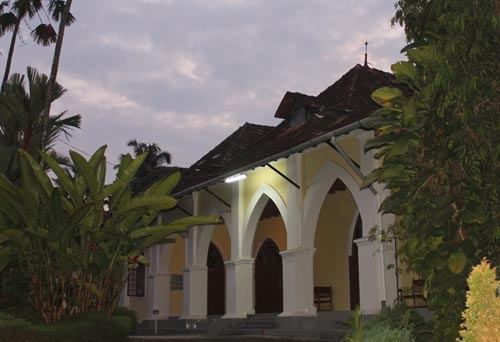Indo Portuguese Museum

Information on Indo Portuguese Museum (Ernakulam, Kerala) - History & Architecture
Indo Portuguese Museum is located inside the Bishop House, Bishop Kureethara Road, Fort Kochi, Cochin City, Ernakulum District, Kerala State, India. It is the Christian art type of museum depicting the Portugal social and cultural impact on the 'Queen of the Arabian Sea' i.e. 'Cochin City'. This is a museum of European cultural importance representing the colonial periods of the Portugal's in Kerala State from (1501 AD to 1950's). This is a heritage tourist place in Fort Kochi to be visited if you are in Cochin.
Indo Portuguese Museum Architecture
Indo Portuguese Museum is built inside the bishop house which was built by the Portuguese in the year (1506 AD) in a mix of Indo European architectural pattern. The Indo Portuguese Museum built inside the bishop house, which also resembles the same architectural design. The construction material used here are large bricks blocks, granite stones, clay tiles teak woods and glasses. This edifice is more over a rectangular shape with one storied floor. Its roof tops are wrapped up with clay tiles in the typical Indian form. It has large halls and corridors. There are beautiful pillars made of stones and woods. It ceilings are covered with teak woods brought from Kotayam. The steps inside the hall are built of wood to reach its 1st floor. Their tops are projected outwards in a pyramid model shape. It has parallel laid pillars in the verandahs letting into the floors easily by all sides of the building. Its window doors are covered with glasses and all doors are made of woods. There are five parts here for display its valuable assets. These are the Alter of 16th century, a treasure house, a processional cross of the 17th century AD, a display hall for its civil life materials, and a cathedral. Altogether it is similar to the bishop's house.
Indo Portuguese Museum History
Indo Portuguese Museum was established in (1910 AD) by the Calouste Gulbenkian, foundation laid by Lisboa of Portugal and this was presided by the Diocese of the Cochin. This museum was devoted in remembrance of Dr.Joseph Kureethara, who was the Bishop of Kochi from (1975 to 1999). It was inaugurated on 6th February 2000 AD. His dream was to preserve these Portuguese art and culture in the memory of colonial rule and their influence with Keralities in making colonial culture in Cochin. Since (1498), the Portuguese explorer Dom Vasco da Gama visited Kochi and made a link to spice trade to Europe. This area was in the interest of Portuguese and many started to settle here in their imperialistic era. Vasco da Gama died in the year (1524 AD) and he was laid to rest in the St.Francis Church. His grave is still maintained by the church in Fort Kochi. In the 14th century AD the Kochi was a tribal village and mostly survived by fishing activity. Now the city is of cosmopolitan set up due to the Portugal impact on this land for more than 500 years. The first propagation of Christianity in Kerala was due to them and many converted to Christianity in their colonial times. Till now there are Portugal decedents, who live in Kochi and practice their religion and culture harmoniously with the Kerala peoples. These Portugal decedents are called Ssaip and Madama's in Kochi. The Portugal cemetery is still in existence due to the presence of these Portugal decedents.
Indo Portuguese Museum Tourism Importance
The Indo Portuguese Museum is the only place to see the past colonial glory by the Portuguese existence in Kochi. All of its historic valuables in terms of art and culture are preserved here. There is no other place in India to see their social and cultural identity.
- Andaman Nicobar Monuments
- Andhra Pradesh Monuments
- Assam Monuments
- Bihar Monuments
- Chhattisgarh Monuments
- New Delhi Monuments
- Goa Monuments
- Gujarat Monuments
- Haryana Monuments
- Himachal Pradesh Monuments
- Jammu and Kashmir Monuments
- Karnataka Monuments
- Kerala Monuments
- Madhya Pradesh Monuments
- Maharashtra Monuments
- Odisha Monuments
- Punjab Monuments
- Rajasthan Monuments
- Tamil Nadu Monuments
- Telangana Monuments
- Uttar Pradesh Monuments
- West Bengal Monuments